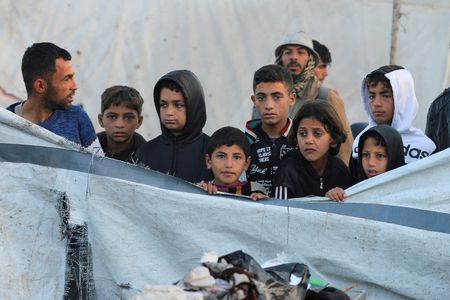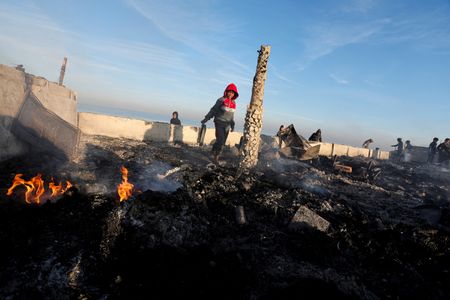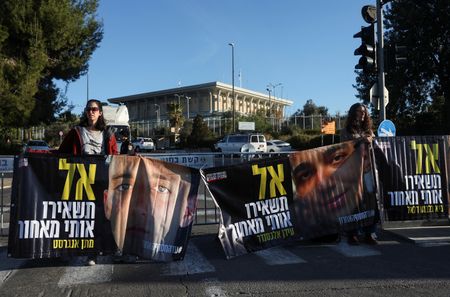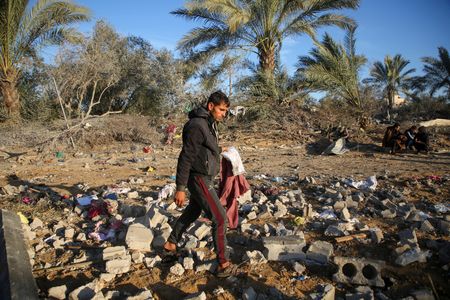By Andrew Mills, Nidal al-Mughrabi and Maayan Lubell
DOHA/CAIRO/JERUSALEM (Reuters) -Negotiators were trying to clinch agreement on Tuesday on the final details of a ceasefire in Gaza after marathon talks in Qatar, with mediators and the warring sides both saying a deal was closer than ever.
However, after more than eight hours of talks, a senior Hamas official told Reuters late on Tuesday that the Palestinian group was still waiting for Israel to submit maps showing how its forces would withdraw from Gaza.
“(Hamas) hasn’t delivered its response yet (to the ceasefire plan) because the occupation (Israel) has not submitted the maps that will show the areas to which its forces will withdraw,” said the official, who asked not to be named due to the sensitivity of the issue.
He added the maps included Israeli withdrawals from the Netzarim area in the middle of the Gaza Strip, to allow the return of the displaced people to their homes, Jabalia in the north of the tiny territory, the Philadelphi road along the southern border with Egypt, and Rafah, also near that border.
Qatar’s foreign ministry spokesperson Majed Al-Ansari earlier told a news conference that talks on the final details were underway after both sides were presented with a text.
U.S. President Joe Biden, whose administration has been taking part alongside an envoy of president-elect Donald Trump, said a deal was close.
Hamas said the talks had reached the final steps and that it hoped this round of negotiations would lead to a deal after mediation by Qatar, Egypt and the United States.
An Israeli official said talks had reached a critical phase although some details needed to be hammered out: “We are close, we are not there yet.”
Militant group Islamic Jihad, which is separate from Hamas and also holds hostages in Gaza, said it was sending a senior delegation that would arrive in Doha on Tuesday night to take part in final arrangements for a ceasefire deal.
“The deal … would free the hostages, halt the fighting, provide security to Israel and allow us to significantly surge humanitarian assistance to the Palestinians who suffered terribly in this war that Hamas started,” Biden said on Monday.
If successful, the phased ceasefire – capping over a year of start-and-stop talks – could halt fighting that decimated Gaza, killed tens of thousands of Palestinians, made most of the enclave’s population homeless and is still killing dozens a day.
That in turn could ease tensions across the wider Middle East, where the war has fuelled conflict in the West Bank, Lebanon, Syria, Yemen and Iraq, and raised fears of all-out war between Israel and Iran.
Israel would recover around 100 remaining hostages and bodies from among those captured in the Oct. 7, 2023 attacks by Hamas that precipitated the war. In return it would free Palestinian detainees.
U.S. Secretary of State Antony Blinken, who gave a speech in Washington outlining a vision for governing the Palestinian territories after the war, said it was up to Hamas to accept a deal that was already set for implementation.
‘LIGHT AT THE END OF THE TUNNEL’
Families of hostages in Israel were on edge.
Meirav Leshem Gonen, whose 24-year-old daughter Romi was shot and seized by gunmen at a music festival, told Radio 103 the family had been picturing her return for months as “the light at the end of the tunnel”.
“We have to keep our feet on the ground. But on the other hand our heads are in the clouds.”
An Israeli official said the deal’s first stage would see the release of 33 hostages, including children, women including some female soldiers, men above 50, and the wounded and sick. Israel would gradually and partially withdraw some forces.
A Palestinian source said Israel would free 1,000 Palestinian prisoners in the first phase over 60 days.
Families of hostages unlikely to be in the first group remained anxious. As Prime Minister Benjamin Netanyahu briefed relatives of some hostages, others protested outside his office.
“The prime minister should bring a deal that includes all the hostages, including my son,” said Ruby Chen, whose soldier son, Itay, was killed in Hamas’ Oct. 7 attack, his body since held in Gaza. “He saved many people, he doesn’t deserve to rot in Gaza.”
Israel launched its assault in Gaza after Hamas-led fighters stormed across its borders on Oct. 7, 2023, killing 1,200 people and taking more than 250 hostages, according to Israeli tallies.
Since then, Israeli forces have killed more than 46,000 Palestinians in Gaza, according to Palestinian health officials.
Only one ceasefire has been held so far, lasting for a single week in November 2023, during which around half of the hostages, including most women, children and foreign labourers, were freed in return for Palestinian detainees.
Both sides have been committed in principle for months to the prospect of a ceasefire accompanied by a swap of remaining hostages for detainees. But previous talks foundered over the steps that would follow, with Hamas rejecting any deal that stopped short of bringing a permanent end to the war, while Israel said it would not end the war until Hamas is dismantled.
Trump’s Jan. 20 inauguration is now widely seen as a de facto deadline for a ceasefire agreement. Trump has said there would be “hell to pay” unless hostages held by Hamas are freed before he takes office, while Biden has also called for a final push for a deal before he leaves.
(Reporting by Andrew Mills in Doha, Nidal Al Mughrabi in Cairo and Maayan Lubell in Jerusalem; additional reporting by Menna Alaa El Din in Cairo; Writing by Michael Georgy and Peter Graff; Editing by Michael Perry, Gareth Jones)














